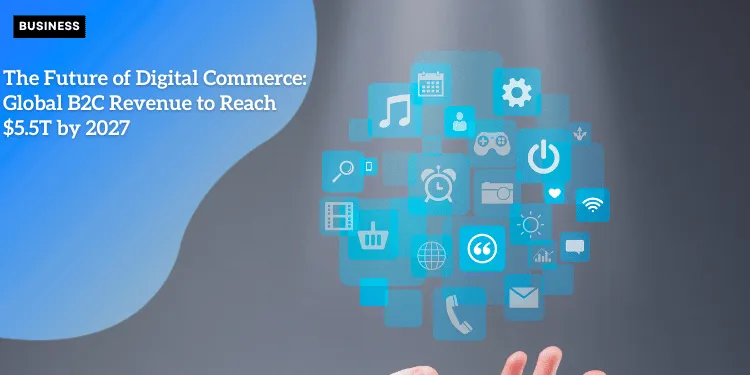The Future of Digital Commerce: Global B2C Revenue to Reach $5.5T by 2027

Anúncios
Ecommerce has become a significant force in the global marketplace, with staggering projected growth numbers.
By 2027, the Business-to-Consumer (B2C) ecommerce market is expected to reach an impressive $5.5 trillion.
This growth is driven by various factors that have reshaped the way we shop and do business online.
 Dólar
Dólar
Overview of Projected Ecommerce Growth Through 2027
The ecommerce sector is on a rapid upward trajectory.
Anúncios
Forecasts show that B2C ecommerce revenue will hit $5.5 trillion by 2027, growing at a compound annual growth rate (CAGR) of 14.4% from 2024 onwards.
This robust growth highlights the increasing reliance on digital platforms for shopping and commerce.
Key Drivers Behind the Expansion of Digital Commerce
Several key factors are fueling the expansion of digital commerce:
Anúncios
- Technology Adoption: Advancements in technology, such as higher internet penetration, the ubiquity of smartphones, and improved logistics, are making online shopping more accessible and convenient for consumers worldwide.
- Consumer Behavior: There is a noticeable shift in consumer behavior towards online shopping, driven by the ease of use, variety of products, and competitive pricing offered by ecommerce platforms.
- Globalization: Digital commerce allows businesses to reach a global audience effortlessly. The removal of geographical barriers has opened new markets and opportunities for retailers and consumers alike.
- Improved Payment Methods: The widespread adoption of secure online payment methods has built consumer trust, making online transactions smoother and safer.
- Personalized Shopping Experience: Enhanced data analytics and machine learning algorithms provide personalized shopping experiences, increasing customer satisfaction and boosting sales.
Significance of Reaching $5.5T in B2C Ecommerce Revenue
Reaching $5.5 trillion in B2C ecommerce revenue is not just a symbolic milestone; it reflects the shifting dynamics of global trade.
This level of revenue signifies:
- 📊 The maturity and stability of the ecommerce market.
- 🤝 Increased consumer trust and participation in digital transactions.
- 🛒 The shift of traditional retail markets to digital platforms.
- 🌍 A broadened horizon for small and medium-sized enterprises (SMEs) to compete on a global scale.
As we move forward, the implications of these changes will be far-reaching, impacting everything from consumer habits to global trade policies.
The continued growth of ecommerce promises both substantial opportunities and challenges for businesses worldwide.
B2B Ecommerce Transformation
B2B ecommerce is poised to witness remarkable growth, with projections showing it will balloon to $36.2 trillion by 2026.
This represents a 50% increase from 2023, showcasing the swift expansion of digital transactions between businesses.
International Trade Administration’s Role
The International Trade Administration (ITA), an agency of the U.S.
Department of Commerce, plays a crucial role in monitoring and nurturing this growth.
The ITA’s primary mission includes promoting trade and investment, ensuring fair trade practices, and strengthening the global competitiveness of U.S. industries.
By overseeing compliance with trade laws and agreements, the ITA helps create a stable and predictable environment for B2B transactions.
Impact on Global Trade and Business Relationships
The rapid growth in B2B ecommerce has significant implications for global trade and business dynamics.
As businesses increasingly adopt digital platforms for their transactions, several key changes are occurring:
- 🚚 Efficient Supply Chains: Digital commerce facilitates smoother and more transparent supply chains, reducing the time and costs associated with traditional trading methods.
- 🌎 Global Market Access: Companies can now easily reach international markets, expanding their customer base and fostering new business relationships.
- 📊 Better Data Utilization: Enhanced data analytics and customer insights help businesses tailor their offerings and improve operational efficiencies.
These shifts not only spur economic growth but also encourage a more interconnected global economy.
As we continue to witness this digital transformation, it’s essential to consider the broader implications for sectors such as electronics, fashion, and pharmaceuticals.
The strategies employed today will pave the way for future successes in an increasingly digital marketplace.
Leading Global Ecommerce Categories
Electronics: The Market Leader
Electronics continue to dominate the global ecommerce landscape, with projected sales set to reach a staggering $922.5 billion.
This significant market share is driven by rapid technological advancements, increasing consumer demand for smart devices, and the widespread adoption of online shopping platforms.
As consumers continue to invest in the latest gadgets, from smartphones to smart home devices, the electronics category is expected to maintain its leading position in the ecommerce sector.
Fashion and Apparel: A Close Contender
Fashion and apparel are emerging as the second-largest category in global ecommerce.
This sector has seen tremendous growth, fueled by the rise of fast fashion brands, the popularity of online-only clothing retailers, and the increasing influence of social media on fashion trends.
The ease of browsing and purchasing clothing online, coupled with personalized shopping experiences, has helped catapult fashion and apparel sales, making it a close contender to electronics.
Pharmaceuticals: The Fastest-Growing Sector
The pharmaceuticals category stands out as the fastest-growing sector in global ecommerce.
This growth is largely attributed to the increasing demand for health and wellness products, the convenience of obtaining prescriptions online, and the expansion of telemedicine services.
As healthcare continues to become more digitized, the online sale of pharmaceuticals is expected to experience robust growth, highlighting the sector’s significant potential.
As we delve deeper into the specific trends shaping the ecommerce landscape, it becomes clear that each category presents unique opportunities and challenges.
Understanding these dynamics is crucial for businesses looking to capitalize on the ongoing digital commerce expansion.
U.S. Market Trends and Forecasts
Fashion Leading U.S. Ecommerce with Projected $162.9B Revenue in 2024
The U.S. ecommerce landscape is set for significant growth, particularly in the fashion sector.
By 2024, fashion ecommerce in the United States is projected to generate $162.9 billion in revenue.
This remarkable growth is driven by consumer demand for both high-end and fast fashion, coupled with the ease and convenience of online shopping.
The rise of mobile commerce and enhanced user experiences also contribute to this surge, making fashion the top revenue category in the U.S. market.
Comparison Between U.S. and Global Market Trends
When comparing U.S. market trends with global ecommerce patterns, both similarities and differences emerge.
Globally, electronics hold the top spot in ecommerce sales with a projected value of $922.5 billion.
However, in the U.S., fashion overtakes electronics as the leading category.
This divergence highlights regional preferences and market dynamics.
For instance, while American consumers are avid online shoppers for apparel, the global market is more heavily skewed towards electronics due to widespread technological adoption and demand across various regions.
Key Growth Categories in the American Market
Aside from fashion, several other categories are driving ecommerce growth in the U.S.
These include:
| Category | Description |
|---|---|
| 📱 Electronics | With continuous technological advancements and a tech-savvy population, electronics remain a strong e-commerce category, boosted by the rise of remote work and digital entertainment. |
| 💪 Health & Wellness | As health-conscious consumers grow, the e-commerce segment for pharmaceuticals, wellness products, and fitness-related items has surged, making it one of the fastest-growing categories. |
| 🏡 Home & Garden | The popularity of DIY projects and home improvement, especially during the pandemic, has driven consistent growth in the home and garden sector, with more consumers purchasing furniture, décor, and gardening supplies online. |
Collectively, these categories underline the diverse interests of American consumers and the evolving ecommerce landscape.
Transitioning into the future outlook, it is essential to consider how these trends will shape ecommerce, with regulatory considerations and trade compliance playing crucial roles.
Future Outlook and Implications
Compound Annual Growth Rate of 14.4% from 2024 to 2027
The ecommerce landscape is set to grow rapidly, with an impressive compound annual growth rate (CAGR) of 14.4% from 2024 to 2027.
This growth is driven by several factors, including advancements in technology, increasing internet penetration, and evolving consumer behaviors.
As more businesses adopt digital transformation strategies, ecommerce will continue to be a crucial channel for both B2C and B2B sectors, leading to wider global market opportunities.
Regulatory Considerations and Trade Compliance
As ecommerce continues to expand, regulatory considerations and trade compliance will play significant roles in shaping its evolution.
Governments and international bodies have the task of ensuring fair trade practices, protecting consumer data, and maintaining the integrity of financial transactions.
Compliance with international trade laws and agreements will be essential for businesses to avoid legal pitfalls and build trust with their customers.
- 🔒 Ensuring data privacy and security
- 🌍 Adhering to international trade laws
- ⚖️ Navigating cross-border regulations
To succeed in the dynamic ecommerce landscape, businesses must be vigilant about regulatory changes and proactive in their compliance efforts.
Opportunities and Challenges in the Evolving Digital Commerce Landscape
The explosive growth of digital commerce brings both opportunities and challenges.
On one hand, businesses have access to a global customer base, innovative payment solutions, and advanced analytics to tailor their offerings.
On the other hand, they must contend with intense competition, logistics hurdles, and cybersecurity threats.
Key Opportunities
- 🌍 Expansion into new markets
- 📦 Diversification of product offerings
- 📊 Leveraging big data for personalized marketing
Challenges
- 🔗 Managing supply chain complexities
- 🛡️ Ensuring robust cybersecurity measures
- 🌐 Adapting to regional regulations
As businesses navigate this fast-paced environment, the ability to adapt and innovate will be critical for sustaining growth and maintaining competitive advantage.
Looking ahead, the ecommerce sector is poised for unprecedented growth, bringing forth both exciting opportunities and complex challenges.
Businesses that can strategically manage these dynamics will be well-positioned for success.
Transitioning from this outlook, the subsequent trends and forecasts will be essential for understanding the direction of major ecommerce markets.
